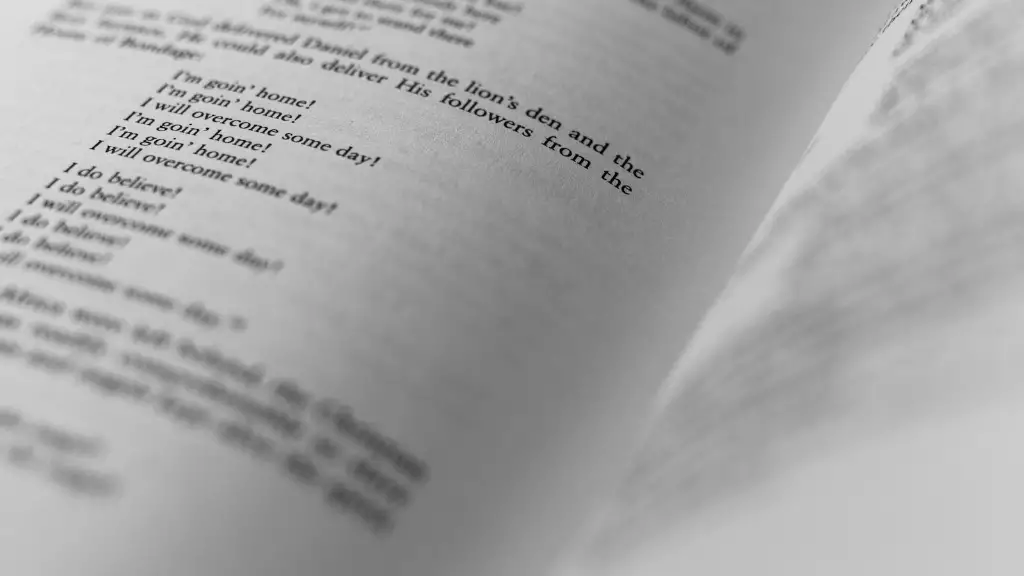Meaning in Sibilance
Sibilance is defined as a ‘hissing’ or ‘murmuring’ sound which is often used to emphasize a word or phrase in a poem. It typically makes use of the letter ‘s’, which creates the recognizable, sibilant sound, but other consonants (such as ‘sh’, ‘z’, ‘ch’ and ‘j’) can also be used. Sibilance acts as kind of musical device, where the poem’s rhythm, sound and tone are all improved upon.
In poetry, sibilance is a form of alliteration, or the repeated use of consonants and vowels within a line of verse. When repeating the ‘s’ sound, an enhanced effect is created due to the physical characteristics of the sound itself, which is interpretively pleasing. Not only does it give the poem more excitement and flair, but it also offers the listener an aural experience which more accurately conveys the poem’s message.
Sibilance and meaningfulness are often linked together. To begin with, the sound of the repeated ‘s’, ‘sh’, ‘z’ and ‘ch’ are often used to express unpleasant thoughts or feelings. For example, Robert Burns’ poem ‘Tam o’ Shanter’ creates a sense of panic and horror with the use of sibilance: “The mirth and fun grew fast and furious; The piper loud and louder blew; The guests began to sweat, yet nought they sweated, compared to Tam o’ Shanter’s brow!” The hissing sound of the consonants is used to emphasize the terror that Tam has experienced.
In contrast, the sound of the repeated ‘s’, ‘sh’, ‘z’ and ‘ch’ can also be used to convey a pleasant feeling. Again, ‘Tam o’ Shanter’ offers one example of this, as the sound of ‘s’ makes the scenery shift from panic to calm during the last stanza: “He’s scour’d away, nor stopp’d to pray, Nor look’d to bid farewell to aught: He scours away, Like Otter-Fish, to his lean haunt in Craigen-Puttock-wood.” The intense fear experienced by the protagonist is mitigated by the gentle sibilance, creating a sense of relief and normalcy in the poem.
In addition, sibilance is quite useful in creative writing, as its tones can effectively convey the intensity of emotion or feeling within a poem. It is also often used to stress a specific word or phrase within the poem, as its consonance draws the reader’s attention to the specific moment. For instance, in Yeats’ poem ‘The Song of Wandering Aengus’, sibilance is used to emphasize the protagonist’s yearning: “I went out to the hazel wood, Because a fire was in my head, And cut and peeled a hazel wand, And hooked a berry to a thread”. The sibilant consonance highlights the protagonist’s search for something he cannot find, as well as emphasizing his emotional ties to nature.
Types of Sibilance
Sibilance can be broken down into two distinct categories – consonance and internal sibilance. Consonance is the repetition of consonants within a line of a poem, which creates the ‘hissing’ effect. Meanwhile, internal sibilance is the ‘echo’ or repetition of the ‘s’ sound in different or multiple words of the same line of a poem.
For example, in ‘She Walks in Beauty’ by Lord Byron, consonance is used, where the repeated ‘s’ sound sets up a rhythm: “She walks in beauty, like the night Of cloudless climes and starry skies, And all that’s best of dark and light Meet in her aspect and her eyes.” The soothing sibilance helps to accentuate the beauty of the beloved subject, conveying her grace and elegance.
Meanwhile, a prime example of internal sibilance can be found in Christina Rossetti’s poem ‘Remember’: “Remember me when I am gone away, Gone far away into the silent land.” Here, the two ‘s’ sounds intertwine and blend together to create a sense of sadness, as the protagonist is about to depart from their loved one.
Symbolism in Sibilance
The use of sibilance often ties into the overall meaning or theme of the poem itself, which can lend an additional layer of depth to the writing. For instance, the character’s reaction to an event or occurrence is often heightened by the use of sibilance. In ‘Tintern Abbey’ by William Wordsworth, the repeated use of ‘s’ emphasizes the protagonist’s awe at the beauty of nature: “The blossoms, birds, and four-fold year Feed my inward flame with luxury, Heard in each and all, by them subdued; Enlarging the circumference of peace.” The poet’s joy is reflected in the ‘s’ sound, and it helps to emphasize the serene atmosphere.
The use of sibilance in literature has long been linked to ideas of nature, mysticism and spirituality. The sound is often used to capture the essence and feel of the natural world, and its usage within both poetry and prose can often provide a ‘breathing room’ within which the writer is able to explore their true emotions, as well as those of their characters. This is why the ‘s’ sound is often associated with poetry and prose, as it serves as a reminder of nature and its beauty.
Sibilance in Contemporary Poetry
Sibilance is a popular device used by contemporary poets and writers alike. Not only does it create an immediate, physical effect, but it can also provide an easy-to-understand means of conveying complex ideas and emotions. In ‘The Love Song of J. Alfred Prufrock’ by T. S. Eliot, the ‘s’ sound expresses the protagonist’s anxiety and dread: “There will be time, there will be time To prepare a face to meet the faces that you meet; There will be time to isolate and martyr.” The ‘s’ sound conveys the tension of the situation, and the protagonist’s feelings of being isolated and persecuted.
In addition, the use of sibilance has also been embraced by younger poets in recent years. For example, the poet and novelist Nely Cab uses sibilance to convey her love for nature and nature’s creatures in her poem ‘A Gift for Wolves”: “I’ll leave you a secret in stones, one that can’t be guessed, and you can kiss me like a river, just to make the cold night melt away.” The ‘s’ sound creates a dream-like atmosphere, as if the listener is taken into a realm of mysticism and beauty.
Conclusion
The use of sibilance in poetry is both a powerful and effective means of emphasizing concepts and ideas. By using this poetic device, the poet has the potential to engage their audience in a unique and interesting way, creating an aural experience which is both aesthetically pleasing, and emotionally resonant. It is a tool which has been used by poets for centuries, and one which will no doubt continue to be used in the years to come.



